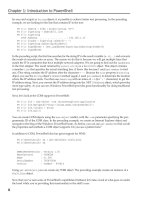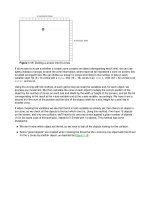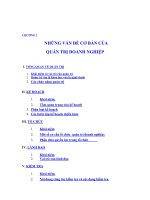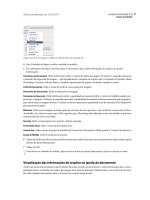Tài liệu WebObjects J2EE Programming Guide- P2 docx
Bạn đang xem bản rút gọn của tài liệu. Xem và tải ngay bản đầy đủ của tài liệu tại đây (565.14 KB, 22 trang )
WebObjects J2EE Programming Guide
(Legacy)
2005-08-11
Apple Inc.
© 2002, 2005 Apple Computer, Inc.
All rights reserved.
No part of this publication may be reproduced,
stored in a retrieval system, or transmitted, in
any form or by any means, mechanical,
electronic, photocopying, recording, or
otherwise, without prior written permission of
Apple Inc., with the following exceptions: Any
person is hereby authorized to store
documentation on a single computer for
personal use only and to print copies of
documentation for personal use provided that
the documentation contains Apple’s copyright
notice.
The Apple logo is a trademark of Apple Inc.
Use of the “keyboard” Apple logo
(Option-Shift-K) for commercial purposes
without the prior written consent of Apple may
constitute trademark infringement and unfair
competition in violation of federal and state
laws.
No licenses, express or implied, are granted
with respect to any of the technology described
in this document. Apple retains all intellectual
property rights associated with the technology
described in this document. This document is
intended to assist application developers to
develop applications only for Apple-labeled
computers.
Every effort has been made to ensure that the
information in this document is accurate. Apple
is not responsible for typographical errors.
Apple Inc.
1 Infinite Loop
Cupertino, CA 95014
408-996-1010
Apple, the Apple logo, Logic, Mac, Mac OS,
Pages, and WebObjects are trademarks of
Apple Inc., registered in the United States and
other countries.
Enterprise Objects and Finder are trademarks
of Apple Inc.
Java and all Java-based trademarks are
trademarks or registered trademarks of Sun
Microsystems, Inc. in the U.S. and other
countries.
Simultaneously published in the United States
and Canada.
Even though Apple has reviewed this document,
APPLE MAKESNO WARRANTY ORREPRESENTATION,
EITHER EXPRESS OR IMPLIED, WITH RESPECT TO
THIS DOCUMENT, ITS QUALITY, ACCURACY,
MERCHANTABILITY, OR FITNESS FOR A PARTICULAR
PURPOSE. AS A RESULT, THIS DOCUMENT IS
PROVIDED “AS IS,” AND YOU, THE READER, ARE
ASSUMING THE ENTIRE RISK AS TO ITS QUALITY
AND ACCURACY.
IN NO EVENT WILL APPLE BE LIABLE FOR DIRECT,
INDIRECT, SPECIAL, INCIDENTAL, OR
CONSEQUENTIAL DAMAGES RESULTING FROM ANY
DEFECT OR INACCURACY IN THIS DOCUMENT, even
if advised of the possibility of such damages.
THE WARRANTY AND REMEDIES SET FORTH ABOVE
ARE EXCLUSIVE AND IN LIEU OF ALL OTHERS, ORAL
OR WRITTEN, EXPRESS OR IMPLIED. No Apple
dealer, agent, or employee is authorized to make
any modification, extension, or addition to this
warranty.
Some states do not allow the exclusion or limitation
of implied warranties or liability for incidental or
consequential damages, so the above limitation or
exclusion may not apply to you. This warranty gives
you specific legal rights, and you may also have
other rights which vary from state to state.
Contents
Introduction
Introduction to WebObjects J2EE Programming Guide 7
Organization of This Document 7
See Also 8
Chapter 1
Servlets 9
Servlets in WebObjects 9
Developing a Servlet 10
Deploying a Servlet 11
Adding Servlet Support to an Existing Application 14
Servlet Single Directory Deployment 15
Cross-Platform Deployment 16
Configuring the Deployment Descriptor 16
Configuring the Servlet Container 17
Installing Servlets in WebSphere 18
Chapter 2
JavaServer Pages 19
JSP Page Writing Guidelines 19
Developing a JavaServer Pages–Based Application 21
Passing Data From a JSP Page to a Component 22
Using WebObjects Classes in a JSP Page 25
Using Direct Actions in JSP Pages 28
Custom-Tag Reference 31
wo:component 31
wo:directAction 32
wo:extraHeader 32
wo:binding 33
wo:formValue 33
Appendix A
Special Issues 35
Deploying Multiple WebObjects Applications in a Single Servlet Container 35
Updating Servlet-Based Applications to Future Versions of WebObjects 36
Document Revision History 37
Glossary 39
Index 41
3
Legacy Document | 2005-08-11 | © 2002, 2005 Apple Computer, Inc. All Rights Reserved.
4
Legacy Document | 2005-08-11 | © 2002, 2005 Apple Computer, Inc. All Rights Reserved.
CONTENTS
Figures, Tables, and Listings
Introduction
Introduction to WebObjects J2EE Programming Guide 7
Table I-1 Servlet containers supported in WebObjects 8
Chapter 1
Servlets 9
Figure 1-1 Hello project directory and Project Builder window 11
Figure 1-2 Build settings for a servlet project 12
Table 1-1 Default host and port in the supported servlet containers 14
Listing 1-1 Contents of Hello.war file 13
Listing 1-2 Contents of the Hello single deployment directory 15
Chapter 2
JavaServer Pages 19
Figure 2-1 JSP_Example project—the Hello component 21
Figure 2-2 JSP_Example project—the output of Welcome.jsp 22
Figure 2-3 JSP_Example project—the DiningWell component 24
Figure 2-4 JSP_Example project—the output of DiningWell.jsp 25
Figure 2-5 JSP_Example project—the MusicGenres component 27
Figure 2-6 JSP_Example project—the output of InternetRadio.jsp 28
Figure 2-7 JSP_Example project—the FoodInquiry component 30
Figure 2-8 JSP_Example project—the output of LogIn.jsp 31
Table 2-1 Custom elements defined in WOtaglib_1_0.tld 20
Table 2-2 Attributes of the wo:component element 31
Table 2-3 Attributes of the wo:directAction element 32
Table 2-4 Attributes of the wo:extraHeader element 32
Table 2-5 Attributes of the binding element 33
Table 2-6 Attributes of the formValue element 33
Listing 2-1 FavoriteFood.java 24
Listing 2-2 InternetRadio.jsp file 26
Listing 2-3 FoodInquiry.java 29
5
Legacy Document | 2005-08-11 | © 2002, 2005 Apple Computer, Inc. All Rights Reserved.
6
Legacy Document | 2005-08-11 | © 2002, 2005 Apple Computer, Inc. All Rights Reserved.
FIGURES, TABLES, AND LISTINGS
Important: The information in this document is obsolete and should not be used for new development.
Links to downloads and other resources may no longer be valid.
Note: This document was previously titled JavaServer Pages and Servlets.
JavaServer Pages (JSP) and servlets are important parts of Sun’s J2EE (Java 2 Platform, Enterprise Edition)
architecture. JSP is a specification that defines interfaces that servlet-container vendors can implement to
provide developers the ability to create dynamic Web pages, which are files with the extension .jsp. Servlet
containers interpret these files and create servlets (also know as workhorse servlets) to process HTTP requests
and produce responses. Servlets are server plug-ins that extend the capabilities of your Web server. They
provide a straightforward deployment mechanism for your applications. Servlets are deployed inside servlet
containers, which are plug-ins to your Web server.
You should read this document if you want to deploy your WebObjects applications inside a servlet container
or want to take advantage of WebObjects components (both standard and custom) in your JSP pages.
Deploying WebObjects applications as servlets allows you to take advantage of the features that your servlet
container provides. Keep in mind that deployment tools such as Monitor and wotaskd do not work with
servlets. WebObjects uses version 2.2 of the Servlet API, and version 1.1 of the JSP specification.
Organization of This Document
The document addresses two major points, each contained in its own chapter:
■ “Servlets” (page 9) explains how you develop WebObjects applications to be deployed as servlets and
how to add servlet capability to existing applications.
■ “JavaServer Pages” (page 19) tells you how to write JSP-based applications, which can be thought of as
JSP applications that use WebObjects technology or hybrids—applications that use JSP pages to
accomplish some tasks and WebObjects components or direct actions to perform others.
■ “Special Issues” (page 35) addresses special issues to consider when you deploy WebObjects applications
as servlets or when you develop JSP-based applications.
■ “Document Revision History” (page 37) lists the revisions made to this document.
Organization of This Document 7
Legacy Document | 2005-08-11 | © 2002, 2005 Apple Computer, Inc. All Rights Reserved.
INTRODUCTION
Introduction to WebObjects J2EE
Programming Guide
See Also
To get the most out of this document, you must be familiar with WebObjects application development. In
particular, you need to know how to create applications using Project Builder and how to layout WebObjects
components using WebObjects Builder.
For additional WebObjects documentation and links to other resources, visit />bobjects.
In addition to WebObjects development experience, you also need to be acquainted with the syntax used
in JSP pages and with the layout of WAR (Web Application Archive) files. You can find information about JSP
and J2EE in the following documents:
■ Java Servlet Programming, 2nd edition (O’Reilly) provides an in-depth treatise on servlets. You can find
more information at .
■ J2EE Technology in Practice (Sun) provides an overview of J2EE technology.
■ JavaServer Pages Technology Syntax (Sun) is a short document that describes the syntax used in JSP pages.
You can download it from For more information on JSP
and servlets, see /> ■ Java Servlet Technology contains the latest information on Sun’s Java Servlet technology. You can view
it at />WebObjects Developer also includes a commented application project that shows you how JSP pages can
take advantage of WebObjects components and direct actions. The example—using the client/server
approach—includes two WebObjects application projects named SchoolToolsClient and SchoolToolsServer.
The projects are located at /Developer/Examples/JavaWebObjects.
The three servlet containers supported in WebObjects are listed in Table I-1.
Table I-1 Servlet containers supported in WebObjects
VersionContainerPlatform
3.2.4TomcatMac OS X Server
7.0WebLogicSolaris
4.0.4WebSphereWindows 2000
8
See Also
Legacy Document | 2005-08-11 | © 2002, 2005 Apple Computer, Inc. All Rights Reserved.
INTRODUCTION
Introduction to WebObjects J2EE Programming Guide
Servlet technology was developed as an improvement over CGI. It’s an open standard that can be freely
adopted by any vendor. It provides an infrastructure that allows applications from different manufacturers
to cooperate and share resources.
The following sections explain how you can take advantage of servlet technology in WebObjects:
■ “Servlets in WebObjects” (page 9) provides an overview of servlet technology as it is implemented in
WebObjects.
■ “Developing a Servlet” (page 10) guides you through creating a simple servlet.
■ “Deploying a Servlet” (page 11) explores deployment issues and tasks you need to keep in mind when
deploying a servlet.
■ “Adding Servlet Support to an Existing Application” (page 14) explains how to add servlet support to
an existing WebObjects application.
■ “Servlet Single Directory Deployment” (page 15) describes the feature that allows you to create a directory
containing the files necessary to deploy an application as a servlet that does not require WebObjects to
be installed on the deployment computer.
■ “Cross-Platform Deployment” (page 16) shows you how to simplify cross-platform deployment (or
deployment in a platform other than the development platform) by allowing you to easily define the
paths your servlet container uses to locate WebObjects frameworks, local frameworks, and WebObjects
application bundles—WebObjects application (WOA) directories.
■ “Installing Servlets in WebSphere” (page 18) addresses special issues when installing WAR files in
WebSphere.
Servlets in WebObjects
Servlets are generic server extensions that expand the functionality of a Web server. By deploying WebObjects
applications as servlets running inside servlet containers, you can take advantage of the features that your
servlet container offers. Alternatively, you can deploy your applications using an HTTP adaptor that runs as
a plug-in in your Web server. The adaptor forwards requests to your servlet container.
WebObjects applications can be deployed as servlets inside a servlet container such as Tomcat, WebLogic,
or WebSphere. When an application runs as a servlet, instead of as a separate Java virtual machine (JVM)
process, it runs inside the servlet container’s JVM, along with other applications. Note, however, that you can
run only one instance of an application inside a servlet container. To run multiple instances of an application,
you have to use multiple servlet containers. In addition, WebObjects deployment tools such as Monitor and
wotaskd cannot be used with servlets.
To deploy an application as a servlet, you need to add the JavaWOJSPServlet framework to your project.
When you build the project, Project Builder generates a WAR (Web application archive) file in addition to the
WOA (WebObjects application) bundle. The WAR file has the appropriate classes and the web.xml file in the
Servlets in WebObjects 9
Legacy Document | 2005-08-11 | © 2002, 2005 Apple Computer, Inc. All Rights Reserved.
CHAPTER 1
Servlets
WEB-INF directory that your servlet container needs to launch the servlet. All you need to do in order to
deploy the servlet is copy the WAR file to the application deployment directory of your servlet container. See
“Installing Servlets in WebSphere” (page 18) for special steps required to install servlets in WebSphere.
You may have to modify web.xml.template, specifically the %WOClassPath% marker, to ensure that the
classpath to the application’s WOA bundle is correct. For WebLogic, the default Session class must be placed
in a package because it conflicts with an internal WebLogic class. In general, all your classes should be inside
packages.
The WAR file is not a complete application. WebObjects Deployment must be installed on the application
host, as well as the application’s WOA bundle. However, using the Servlet Single Directory Deployment
feature, you can deploy directories that contain all the necessary WebObjects classes. For more information,
see “Servlet Single Directory Deployment” (page 15).
Note: When a WebObjects application is deployed as a servlet, the main method of the Application class is
not executed.
Developing a Servlet
This section shows you how to create a simple servlet using Project Builder.
Start by creating a WebObjects application project named Hello. You can deploy other types of WebObjects
applications as servlets, such as Direct to Java Client, Direct to Web, Display Group, and Java Client.
In the Enable J2EE Integration pane of the Project Builder Assistant, select Deploy in a JSP/Servlet Container.
10
Developing a Servlet
Legacy Document | 2005-08-11 | © 2002, 2005 Apple Computer, Inc. All Rights Reserved.
CHAPTER 1
Servlets
The “Deploy as a WAR file” option tells Project Builder to create a WAR file, which should be placed in your
servlet container’s application directory. The WAR file contains all the files needed by an application except
WebObjects frameworks. Therefore, WebObjects needs to be installed on the computer on which you want
to deploy the application.
The “Deploy as a Servlet Single Directory Deployment” option tells Project Builder to include WebObjects
frameworks in the WAR file. With this option, WebObjects does not need to be installed on the deployment
computer.
The “Copy all JAR files into the application’s WEB-INF/lib directory” option tells Project Builder to copy
framework and application JAR files to the WEB-INF/lib directory (necessary only when the servlet uses
other servlets, or for JSPs that make use of actual objects).
As the right side of Figure 1-1 shows, the newly created project is, in all respects, a standard WebObjects
application project. However, Project Builder adds the Servlet Resources folder to the Resources group.
Anything you add to this folder is included in the WAR file or single deployment directory that Project Builder
creates when you build the project, following the same directory structure. The Servlet Resources folder is a
real directory in the project’s root directory; it’s shown on the left side of Figure 1-1.
Figure 1-1 Hello project directory and Project Builder window
Deploying a Servlet
The WEB-INF folder, under Server Resources, contains the web.xml.template file, which Project Builder
uses to generate the servlet’s deployment descriptor. You can edit this template to customize the deployment
descriptor for your deployment environment. There are several elements whose values are surrounded by
percent (%) characters (these are placeholders that Project Builder evaluates when you build the project).
These elements include cross-platform settings (see “Cross-Platform Deployment” (page 16) for details). You
can replace the placeholders with other values if your environment requires it.
Follow these steps to get to the JSP and servlet build settings in Project Builder:
Deploying a Servlet 11
Legacy Document | 2005-08-11 | © 2002, 2005 Apple Computer, Inc. All Rights Reserved.
CHAPTER 1
Servlets
1. Click the Targets tab, then click the Hello target in the Targets list. The Target pane appears. It contains
the target settings list and a content pane.
2. Click Expert View under Settings in the target settings list to display the Hello target’s build settings in
the content pane.
3. Locate the SERVLET_WEBAPPS_DIRbuild setting and enter the path of your servlet container’s application
directory, as shown in Figure 1-2.
Figure 1-2 Build settings for a servlet project
The SERVLET_COPY_JARS build setting tells Project Builder whether to copy framework and application JAR
files to the WEB-INF/lib directory (necessary only when the servlet uses other servlets, or for JSPs that make
use of actual objects).
The SERVLET_SINGLE_DIR_DEPLOYbuild setting indicates whether the application is to be deployed as a
WAR file or a single deployment directory (see “Servlet Single Directory Deployment” (page 15) for more
information). Set it to NO to deploy as a WAR file and YES to deploy as a single deployment directory.
The SERVLET_SINGLE_DIR_DEPLOY_LICENSEbuild setting must contain your WebObjects Deployment
license when SERVLET_SINGLE_DIR_DEPLOY is set to YES. If you don’t add your deployment license, you
will not be able to build the application.
You can tell Project Builder where to put the WAR file by setting the value of the SERVLET_WEBAPPS_DIR
build setting (this is especially convenient during development). By default, WAR files are placed in the build
directory of your project.
Project Builder WO (on Windows) adds two buckets to your project: JSP Servlet WEB-INF and JSP Servlet
Resources. The JSP Servlet WEB-INF bucket is a holding place for JAR files, classes, and TLD files (which are
auto-routed to the correct subdirectories in the WEB-INF directory of the generated WAR file or single
deployment directory—lib, class, and tld respectively; the web.xml.template file is also located here).
The JSP Servlet Resources bucket contains any other items you want to add to the WAR file or single
deployment directory (you can drag files and folders into this bucket; Project Builder WO preserves the
directory structure when it generates the WAR file). These items are not auto-routed.
12
Deploying a Servlet
Legacy Document | 2005-08-11 | © 2002, 2005 Apple Computer, Inc. All Rights Reserved.
CHAPTER 1
Servlets
There are also several new variables defined in Makefile.preamble. The SERVLET_APP_MODE variable
indicates whether Web server resources are loaded from the WOA bundle (the default) or the servlet container
(by setting it to "Deployment". The SERVLET_WEBAPPS_DIR, SERVLET_COPY_JARS,
SERVLET_SINGLE_DIR_DEPLOY, and SERVLET_SINGLE_DIR_DEPLOY_LICENSE variables perform the same
function described for Project Builder’s servlet-related build settings earlier.
This is how you set up the SERVLET_WEBAPPS_DIR variable in Project Builder WO:
export SERVLET_WEBAPPS_DIR = C:\Tomcat\webapps
You can test the servlet by setting the SERVLET_WEBAPPS_DIR build setting to the path of your servlet
container’s application deployment directory and building the project. Before you build, you can edit Main.wo
using WebObjects Builder to add a message to the page, such as Hello. I’m a servlet. When Project
Builder finishes building the application, it places the Hello.war file in your servlet container’s application
deployment directory. The contents of the Hello.war file are shown in Listing 1-1.
Listing 1-1 Contents of Hello.war file
Hello/
META-INF/
MANIFEST.MF
WEB-INF/
classes/
lib/
JavaWOJSPServlet_client.jar
tlds/
WOtaglib_1_0.tld
web.xml
After restarting your servlet container you can connect to the Hello application through a Web browser. By
default, the connection URL is
http://host:port/AppName/WebObjects/AppName.woa
where host is the computer where the servlet container is running and port is the port the container runs
on. Table 1-1 lists the default host and port for Tomcat, WebLogic, and WebSphere.
Deploying a Servlet 13
Legacy Document | 2005-08-11 | © 2002, 2005 Apple Computer, Inc. All Rights Reserved.
CHAPTER 1
Servlets
Table 1-1 Default host and port in the supported servlet containers
PortHostContainer
8080 (9006 on Mac OS X Server)localhostTomcat
7001localhostWebLogic
9080localhostWebSphere
Adding Servlet Support to an Existing Application
To add servlet support to an existing application, all you need to do is add the JavaWOJSPServlet framework
to your project and rebuild it. On Mac OS X, follow these steps:
1. Open the project you want to add servlet support to in Project Builder.
2. Add the JavaWOJSPServlet framework.
a. Select the Frameworks group from the Files list.
b. Choose Project > Add Frameworks.
A sheet appears with the Frameworks folder selected.
c. Select JavaWOJSPServlet.framework from the file list, and click Open.
d. Select Application Server from the target list, and click Add.
Notice that the Servlet Resources folder is added to the Resources group.
3. Build the project using the Deployment build style.
4. Copy the WAR file or deployment directory in the build directory of your project to the application
deployment directory of your servlet container.
You can avoid this step by setting SERVLET_WEBAPPS_DIR to the path of your servlet container’s
application deployment directory. When using SSDD, you have to add your WebObjects Deployment
license number to the project, as explained in “Deploying a Servlet” (page 11).
5. If necessary, restart your servlet container.
The servlet should now be available through your servlet container.
On Windows, follow these steps:
1. Open the project you want to add servlet support to in Project Builder WO.
2. Add the JavaWOJSPServlet framework.
a. Select the Frameworks bucket.
14
Adding Servlet Support to an Existing Application
Legacy Document | 2005-08-11 | © 2002, 2005 Apple Computer, Inc. All Rights Reserved.
CHAPTER 1
Servlets
b. Choose Project > Add Files.
c. If necessary, navigate to the \Apple\Library\Frameworks directory (the directory should be
selected by default).
d. Select JavaWOJSPServlet.framework from the file list and click Open.
e. Add the servlet-support variables to the Makefile.preamble file. One way to do this is by creating
a new project with servlet support and copying its servlet-related variables to the
Makefile.preamble in the project you’re modifying.
3. Rebuild the project.
4. If necessary, copy the WAR file or single deployment directory in the project’s build directory to the
application deployment directory of your servlet container. On Windows, the WAR file or single deployment
directory is located at the top level of the project’s directory.
5. If necessary, restart your servlet container.
Servlet Single Directory Deployment
As mentioned earlier, Servlet Single Directory Deployment (SSDD) allows you to create an application directory
that you can deploy on a computer on which WebObjects is not installed.
To deploy an application using SSDD, do the following:
1. Set the SERVLET_SINGLE_DIRECTORY_DEPLOY build setting to YES.
2. Enter your WebObjects Deployment license as the value of the
SERVLET_SINGLE_DIRECTORY_DEPLOY_LICENSE build setting.
When you build the application, Project Builder creates a directory named after the project. Listing 1-2 lists
the contents of the Hello deployment directory.
Listing 1-2 Contents of the Hello single deployment directory
Hello/
WEB-INF/
classes/
// 1
Extensions
Hello.woa
lib/
JavaWOJSPServlet_client.jar
// 2
Library
Frameworks/
// 3
LICENSE
tlds/
WOtaglib_1_0.tld
web.xml
The following list explains the numbered items in Listing 1-2.
Servlet Single Directory Deployment 15
Legacy Document | 2005-08-11 | © 2002, 2005 Apple Computer, Inc. All Rights Reserved.
CHAPTER 1
Servlets
1. The Extensions directory contains the JAR files in /Library/WebObjects/Extensions.
2. The Library directory contains the frameworks in the Frameworks group of the Files list of the project.
3. The LICENSE file contains the WebObjects Deployment license agreement.
Cross-Platform Deployment
To support cross-platform deployment, WebObjects uses three variables that tell the servlet container at
runtime where to find WebObjects frameworks (directories with the .framework extension) and the WOA
bundles (bundles with the extension .woa):
■ WOROOT indicates the path where WebObjects frameworks are installed. On Mac OS X, for example,
WebObjects frameworks are located in the /System/Library/Frameworks directory and WOROOT is
set to /System. On Windows, WOROOT could be set to C:\Apple, and on Solaris it may be /opt/Apple.
■ LOCALROOT indicates the path where local frameworks are installed. On Mac OS X, these frameworks
are located in the /Library/Frameworks directory, and LOCALROOT is set to /. On Windows, LOCALROOT
may be set to C:\Apple\Local, while on Solaris it could be /opt/Apple/Local.
■ WOAINSTALLROOT specifies the location of WOA bundles. On Mac OS X, the default is
/Library/WebObjects/Applications.
When you deploy the WAR file of your servlet on a computer where the framework and WOA files are in
different locations from the default ones, you can specify the correct paths using the variables described
above. You can accomplish this in two ways:
■ configuring the application’s deployment descriptor
■ configuring the servlet container
Note: Single directory deployments, described in “Servlet Single Directory Deployment” (page 15), are
platform independent.
Configuring the Deployment Descriptor
The deployment descriptor of a servlet is the web.xml file, located in the WEB-INF directory of the WAR file.
This file is generated from the web.xml.template file in your project.
To configure your application’s deployment descriptor during development, you edit the web.xml.template
file. Alternatively, you can edit the web.xml file of the WAR file (after expanding the WAR file). Locate the
<param-name> tags for the appropriate variables, and set the value for their corresponding <param-value>
tag.
This is an example of a web.xml.template file on Windows:
<web-app>
<context-param>
<param-name>WOROOT</param-name>
16
Cross-Platform Deployment
Legacy Document | 2005-08-11 | © 2002, 2005 Apple Computer, Inc. All Rights Reserved.
CHAPTER 1
Servlets
<param-value>C:\WebObjectsFrameworks</param-value>
</context-param>
<context-param>
<param-name>LOCALROOT</param-name>
<param-value>C:\Apple\Local</param-value>
</context-param>
<context-param>
<param-name>WOAINSTALLROOT</param-name>
<param-value>C:\WebObjectsApplications</param-value>
</context-param>
</web-app>
You expand the WAR file by executing the following commands in your shell editor:
mkdir filename
jar -xvf filename.war
When you’re done editing the web.xml file, you re-create the WAR file by executing
jar -cvf fileName.war .
Configuring the Servlet Container
This method allows your settings to be propagated to all applications and it overrides the values set in the
deployment descriptor. Using this approach, you can deploy WebObjects applications without worrying
about each application’s configuration. You can configure the servlet container in two ways:
■ editing the launch script of the servlet container
■ defining environment variables
This is an example of the launch script in Tomcat (startup.sh):
#! /bin/sh
$JAVACMD $TOMCAT_OPTS -DWOROOT=/System -DLOCALROOT=/
-DWOAINSTALLROOT=/Library/WebObjects/Applications
-Dtomcat.home=${TOMCAT_HOME} org.apache.tomcat.startup.Tomcat "$@" &
BASEDIR='dirname $0'
$BASEDIR/tomcat.sh start "$@"
This is an example of the launch-script format in WebLogic (startWLS.sh):
"${JAVA_HOME}/bin/java" ${JAVA_VM} ${MEM_ARGS}
-classpath ${CLASSPATH}"
-Dweblogic.Name=myserver
-Dbea.home="/opt/bea"
"-DWOROOT=/opt/Apple"
"-DLOCALROOT=/opt/Apple/Local"
"-DWOAINSTALLROOT=/applications/production"
-Dweblogic.management.username=${WLS_USER}
-Dweblogic.management.password=${WLS_PW}
-Dweblogic.ProductionModeEnabled=${STARTMODE}
-Djava.security.policy="${WL_HOME}/server/lib/weblogic.policy"
Cross-Platform Deployment 17
Legacy Document | 2005-08-11 | © 2002, 2005 Apple Computer, Inc. All Rights Reserved.
CHAPTER 1
Servlets
weblogic.Server
This is how you would define environment variables using the bash or zsh shell editors:
% export TOMCAT_OPTS="-DWOROOT=/System -DWOAINSTALLROOT=/WebObjects/Applications
-DLOCALROOT=/"
And this is how you would do it using the csh shell editor:
% setenv TOMCAT_OPTS "-DWOROOT=/System -DWOAINSTALLROOT=/WebObjects/Applications
-DLOCALROOT=/"
Installing Servlets in WebSphere
To install a single deployment directory you need to create a WAR file from the directory. Execute the following
commands to create the WAR file:
cd <path-to-project>/AppName
jar -cvf AppName.war .
To install a WAR file, perform these steps using console:
1. Choose Nodes > Server > Enterprise Apps > Install.
2. Navigate to the WAR file’s location.
3. Enter the application’s name in the App Name text input field; for example, MyApp.
4. Enter the context name for the application in the Context Root text input field; for example, /MyApp.
18
Installing Servlets in WebSphere
Legacy Document | 2005-08-11 | © 2002, 2005 Apple Computer, Inc. All Rights Reserved.
CHAPTER 1
Servlets
JavaServer Pages (JSP) is a specification that describes what a servlet-based content creation system should
do. One of its main purposes is to facilitate the creation of dynamic Web pages.
You can directly access WebObjects components in your JSP pages. These components can be WOComponents
or WODirectActions. This allows you to create JSP-based applications that take advantage of WebObjects
technologies, such as Enterprise Objects.
When your servlet container receives a request addressed to a JSP page, the container reads the .jsp file
and compiles it into a workhorse servlet that processes the HTTP requests and produces responses to them.
This chapter addresses the following topics:
■ “JSP Page Writing Guidelines” (page 19) introduces the custom tag library that your JSP pages must
include to be able to access WebObjects components.
■ “Developing a JavaServer Pages–Based Application” (page 21) walks you through the steps needed to
create a simple JSP-based application.
■ “Passing Data From a JSP Page to a Component” (page 22) explains what you need to do in order to
pass data from a JSP page to a WebObjects component or direct action.
■ “Using WebObjects Classes in a JSP Page” (page 25) shows you how to write JSP pages that use
WebObjects classes.
■ “Using Direct Actions in JSP Pages” (page 28) explains how to use a direct action in a JSP page.
■ “Custom-Tag Reference” (page 31) provides a detailed explanation for each of the tags defined in the
custom tag library.
JSP Page Writing Guidelines
To be able to use WebObjects components in your JSP pages, you have to include the WOtaglib_1_0.tld
custom tag library. It’s located in
/System/Library/Frameworks/JavaWOJSPServlet.framework/Resources. This custom tag library
uses the tag library descriptor format defined in a DTD (Document Type Definition) from Sun. This DTD is
available at />The elements you use in your JSP pages have the form <wo:elementName>. elementName indicates the
type of element you want to use. For example, to use a component element within a JSP page, you add code
like the following to the .jsp file:
<wo:component >
</wo:component>
Version 1.0 of the custom tag library defines five tags as described in Table 2-1.
JSP Page Writing Guidelines 19
Legacy Document | 2005-08-11 | © 2002, 2005 Apple Computer, Inc. All Rights Reserved.
CHAPTER 2
JavaServer Pages
Table 2-1 Custom elements defined in WOtaglib_1_0.tld
DescriptionChildrenElement
Top-level element. Specifies the component that is used
in the JSP page.
bindingextraHeaderwo:component
Top-level element. Specifies the direct action that is used
in the JSP page.
formValueextraHeaderwo:directAction
Specifies the extra HTTP headers to be passed to the
component or direct action.
Nonewo:extraHeader
Specifies the key-value pair to be passed to the
containing wo:component for binding.
Nonewo:binding
Specifies the form value to be passed to the containing
wo:directAction.
Nonewo:formValue
For detailed information on the WebObjects custom tag library, see “Custom-Tag Reference” (page 31).
To use the wo:component or wo:directAction elements on a JSP page, you must add the following
directive to the page:
<%@ taglib uri="/WOtaglib_1_0.tld" prefix="wo" %>
When you need to access WebObjects classes or objects from your JSP page, you need to copy all the
framework and application JAR files necessary into the WAR file or single deployment directory. You accomplish
this by calling the initStatics method of the WOServletAdaptor class:
<% WOServletAdaptor.initStatics(application); %>
Note that you need to invoke the initStatics method only once during the lifetime of an application.
Furthermore, the method is invoked automatically anytime wo:component or wo:directAction elements
are used in a JSP page.
You also need to import the appropriate packages before using the classes with the import attribute of the
page directive in your JSP page:
<%@ page import = "com.webobjects.jspservlet.*" %>
These directives need to be performed only once per page. However, additional invocations have no ill effect.
Referencing classes directly is useful when using components that require binding values. For example, a
WORepetition whose list attribute is bound to an array of enterprise-object instances.
This is an example of a directAction definition:
<wo:directAction actionName="random" className="DirectAction">
<wo:formValue key = "formKey" value = '<%= "formValue" %>'/>
<wo:extraHeader key = "headerKey" value = '<%= "headerValue" %>'/>
</wo:directAction>
This is an example of a component definition:
<wo:component className="MyImageComponent">
<wo:binding key="filename" value='<%= "start.gif" %>' />
20
JSP Page Writing Guidelines
Legacy Document | 2005-08-11 | © 2002, 2005 Apple Computer, Inc. All Rights Reserved.
CHAPTER 2
JavaServer Pages
</wo:component>
To embed dynamic elements in a JSP page, such WOConditional and WORepetition, you have to wrap them
in a WebObjects component, which you then use in your JSP page.
Developing a JavaServer Pages–Based Application
This section shows you how to create a simple JSP-based WebObjects application. In it you learn how to use
wo:component elements in a JSP page.
1. Launch Project Builder and create a WebObjects application project called JSP_Example.
2. In the J2EE Integration pane of the Project Builder Assistant, select “Deploy in a servlet container.”
3. In Project Builder, create a component called Hello (make sure you assign it to the Application Server
target). Edit the component using WebObjects Builder so that it looks like Figure 2-1.
Figure 2-1
JSP_Example project—the Hello component
4. Set the servlet application directory. (See “Deploying a Servlet” (page 11) for details.)
5. In the Finder, navigate to the Servlet Resources folder, located in the JSP_Example folder, and create a
folder called jsp.
6. Using a text editor, create a file with the following contents:
<% Welcome.jsp %>
<%@ taglib uri="/WOtaglib" prefix="wo" %>
Developing a JavaServer Pages–Based Application 21
Legacy Document | 2005-08-11 | © 2002, 2005 Apple Computer, Inc. All Rights Reserved.
CHAPTER 2
JavaServer Pages
<HTML>
<HEAD>
<TITLE>Welcome to JavaServer Pages in WebObjects</TITLE>
</HEAD>
<BODY>
<wo:component className="Hello">
</wo:component>
</BODY>
</HTML>
7. Save the file as Welcome.jsp in the jsp directory.
8. Build the JSP_Example project (if necessary, restart your servlet container).
You should now be able to connect to your application. In Tomcat, you use the following URL:
http://localhost:8080/JSP_Example/jsp/Welcome.jsp
A page similar to the one in Figure 2-2 should appear in your browser. (Otherwise, consult your servlet
container’s documentation to make sure that it’s configured properly.)
Figure 2-2 JSP_Example project—the output of Welcome.jsp
Passing Data From a JSP Page to a Component
In this section, you expand the JSP_Example project to include
■ a new component called FavoriteFood
■ a JSP page, called DiningWell, that uses the Hello and FavoriteFood components to generate its output
22
Passing Data From a JSP Page to a Component
Legacy Document | 2005-08-11 | © 2002, 2005 Apple Computer, Inc. All Rights Reserved.
CHAPTER 2
JavaServer Pages









